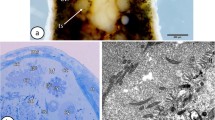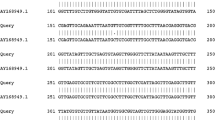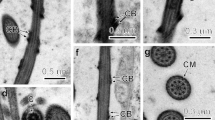Summary
The spermatophore ofMyzostoma cirriferum is a white V-shaped structure up to ca. 500 μm long. It is formed by a translucent matrix which includes numerous cysts of two types that are very close together and tend to form interlacing twists. According to their contents, three spermatophoral regions can be distinguished: the body with the horns, the foot and the basal disc. The body-horns region forms the upper part of the spermatophore and extends over ca. 400 μm. This region includes mature spermiocysts which are formed by one cyst cell each including one to three groups of rolled up spermatozoons. Features of these cyst cells are their great length (up to 25 μm), their euchromatic nuclei each provided with a large nucleolus, their numerous mitochondria and osmiophilic vesicles included in the cytoplasm as well as cytoplasmic remnants of the residual bodies of the spermatids. Spermatozoons appear to be well adapted to the intradermic penetration occurring in this species in that all of them possess nuclei provided with dense nuclear grains, a hairpin-bent flagellum and a microtubular palissade. The spermatophore foot is located just below the body and extends over ca. 90 μm. It contains exclusively spermiocysts which include one to three abortive germinal cells. They differ also from the previous cysts by their smaller length (ca. 6–10 μm) and their more heterochromatic nuclei. The basal disc is the lower part of the spermatophore. It extends over ca. 10 μm and contains electron-dense vesicles in its upper part and vesicles with fibrillar material in its lower part. When mature myzostomids contact each other, a spermatophore is expulsed from one seminal vesicle of the donor myzostomid to the integument of the receiver myzostomid. The vesicles with fibrillar content are the first in contact with the cuticle of the receiver myzostomid. The material they include is supposed to have a histolytic action and to be responsible for the lysis of the cuticle and epidermal cells thus providing a passage for the spermatophore contents. Afterwards, cysts move as a result of the spermatozoons' beating and pass through the receiver's integument. At the time of penetration, cytoplasmic membranes of the cyst cells merge together forming an enormous syncytium extending into the whole receiver's body. This syncytium surrounds the spermatozoons and the abortive germinal cells. The whole process of intradermic penetration (i.e. from the fixation of the spermatophore to its reduction to an empty matrix) lasts from 1–5 h.
Similar content being viewed by others
References
Afzelius BA (1983) The spermatozoon ofMyzostomum cirriferum (Annelida, Myzostomida). J Ultrastruct Res 83:58–68
Afzelius BA (1984) Spermiogenesis inMyzostomum cirriferum (Annelida, Myzostomida). Vidensk Medd Dan Naturhist Foren Khobenhavn 145:11–21
Aloia RC, Moretti RL (1973) Mating behavior and ultrastructural aspects of copulation in the rotiferAsplanchna brightwelli. Trans Am Microsc Soc 92:371–380
Amin OM (1981) Leeches (Hirudinea) from Wisconsin, and a description of the spermatophore ofPlacobdella ornata. Trans Microsc Soc 100:42–51
Anderson JM (1950) A cytological and cytochemical study of the testicular cyst cells in the Japanese beetle. Physiol Zool 23:308–316
Apelt G (1969) Fortpflanzungsbiologie, Entwicklungszyklen und vergleichende Frühentwicklung acoeler Turbellarien. Mar Biol 4:267–325
Beard J (1884) On the life history and development of the genusMyzostoma (F.S. Leuckart). Mitt Zool Stat Neapel 5:544–580
Beard J (1898) The sexual condition ofMyzostoma glabrum (F.S. Leuckart). Mitt Zool Stat Neapel 13:293–324
Carayon J (1974) Insémination traumatique hétérosexuelle chezXylocoris maculipennis (Hém. Anthocoridae). C R Acad Sci Paris 278 (D): 2803–2806
Cuénot L (1949) Les Onychophores. In: Grassé P (ed) Traité de Zoologie, vol 6. Masson, Paris, pp 3–75
Damas D (1969) Origine et structure du spermatophore deGlossiphonia complanata (L) (Hirudinée, Rhynchobdelle). Arch Zool Exp Gén 109:79–86
Edwards JS (1961) On the reproduction ofPrionoplus reticularis (Coleoptera, Cerambycidae) with general remarks on reproduction in the Cerambycidae. J Microsc Sci 102:519–529
Eeckhaut I (1989) Développement et reproduction deMyzostomum cirriferum (Leuckart) (Polychaeta, Myzostomidae). Master thesis, Université de Mons-Hainaut, Belgium
Eeckhaut I, Lahaye MC, Jangoux M (1990) Postmetamorphic development ofMyzostomum cirriferum (Annelida) and effects of the symbiote on its crinoid host,Antedon bifida (Echinodermata). In: De Ridder C, Dubois P, Lahaye MC, Jangoux M (eds) Echinoderm research. Balkema, Rotterdam, pp 317–321
Franzén A, Rice SA (1988) Spermatogenesis, male gametes and gametes interactions. In: Westheide W, Hermans CO (eds) The ultrastructure of polychaeta. Gustav Fischer, Stuttgart New York, pp 309–334
Ganter P, Jollés G (1969–1970) Histochimie normale et pathologique, 2 vols. Gauthier-Villars, Paris, 1904 pp
Harant H, Grassé P (1959) Classe des Annélides Achètes ou Hirudinées ou Sangsues. In: Grassé P (ed) Traité de Zoologie, vol 5. Masson, Paris, pp 471–593
Jägersten G (1934) Studien über den histologischen Bau der männlichen Geschlechtsorgane und die Ausbildung des Spermiums beiMyzostomum. Zool Bidr Uppsala 15:1–22
Jägersten G (1939) Über die Morphologie und Physiologie des Geschlechtsapparats und den Kopulationsmechanismus der Myzostomiden. Zpol Bidr Uppsala 18:163–242
Jägersten G (1944) Über den Bau des Kopulationsapparates und Kopulationsmechanismus beiDinophilus. Zool Bidr Uppsala 22:61–86
Jangoux M (1987) Diseases of Echinodermata. III. Agents metazoans (Annelida to Pisces). Dis Aquat Org 3:59–83
Kato K (1952) On the development ofMyzostoma. Sci Rep Saitama Univ 1 (1):1–16
Khoeler KJ, Birky CW (1966) An electron microscope study of the dimorphic spermatozoa ofAsplanchna (Rotifera). Z Zellforsch 70:303–321
Mattei X, Marchand B (1987) Les spermatozoïdes des acanthocéphales et des myzostomides. Ressemblances et conséquences phylétiques. C R Acad Sci Paris 305:525–529
Mattei X, Marchand B (1988) La spermiogénèse deMyzostomum sp. (Procoelomata, Myzostomida). J Ultrastruc Res 100:75–85
Prenant M (1959) Classe des myzostomides. In: Grassé P (ed) Traité de Zoologie, vol 5 (1). Masson, Paris, pp 714–784
Roosen-Runge EC (1977) The process of spermatogenesis in animals. Cambridge University Press, Cambridge, 214 pp
Schroeder PC, Hermans CO (1975) Annelida: Polychaeta. In: Giese AC, Pearse JS (eds) Reproduction of marine invertebrates, 3, Annelids and echiurans. Academic Press, New York, pp 1–213
Sterrer W (1974) Gnathostomulida. In: Giese AC, Pearse JS (eds) Reproduction of marine invertebrates, vol 1, Acoelomate and pseudocoelomate Metazoans. Academic Press, London, pp 345–357
Stummer-Traunfels RR Von (1926) Myzostomida. In: Kükenthal W (ed) Handbuch der Zoologie 3. De Gruyter, Berlin, pp 132–210
Westheide W (1984) The concept of reproduction in polychaetes with small body size: adaptations in interstitial species. In: Fischer A, Pfannenstiel HD (eds) Polychaete reproduction. Gustav Fischer, Stuttgart New York, pp 265–288
Westheide W (1988) Genital organs. In: Westheide W, Hermans CO (eds) The ultrastructure of polychaeta. Gustav Fischer, Stuttgart New York, pp 263–280
Wheeler WM (1896) The sexual phases ofMyzostoma. Mitt Zool Stat Neapel 12:227–302
Wheeler WM (1898) The maturation, fecundation and early cleavage ofMyzostoma glabrum Leuckart. Arch Biol 15:1–77
Author information
Authors and Affiliations
Rights and permissions
About this article
Cite this article
Eeckhaut, I., Jangoux, M. Fine structure of the spermatophore and intradermic penetration of sperm cells inMyzostoma cirriferum (Annelida, Myzostomida). Zoomorphology 111, 49–58 (1991). https://doi.org/10.1007/BF01632709
Received:
Issue Date:
DOI: https://doi.org/10.1007/BF01632709




